|
|
|
| The next things are essential if you want to photograph nighttime lightning: EQUIPMENT The next things are essential if you want to photograph nighttime lightning: a camera; a lens; a tripod; a cable-release; some film modules. ...and these items are optional, but can be of great help: a torch; a small SW/MW radio receiver, or a lightning detector; a spare camera with film loaded; a spare cable release; a plastic bag or something; a small screwdriver or other sharp tool; a watch, pen and paper. Camera First, you'll need a camera. I recommend using a manual camera, or else an automatic camera which can be set to some sort of manual mode. It doesn't matter much which camera to use, as long as it meets the following specifications: the ability to set the shutter-speed to bulb setting 'B' (manual shutter control); the ability to use a separate lens. If it's equipped with a fixed (zoom)lens, this lens must have manually adjustable aperture and focus; it needs to have the option to mount a cable-release on it (in most cases the cable release will be connected to the release button itself); the camera lens with which it will be used has to fit on the fastening ring of the camera; usage of common film modules (35x28 mm)... (although a camera for 60x60 mm film or slides is much better because the effective resolution is much better... but these types of film are expensive, not to mention the camera); a functioning light sensor is optional but not of any use to photograph nighttime lightning. I use one of three cheap cameras, all SLR (mirror-reflex) cameras, not over , dating back to the seventies or older, third-hand or worse. These cheap cameras are perfect to get started photographing lightning. So go visit a photographic equipment store and look for the cheapest second-hand camera which meets the specifications mentioned above. Expect to spend about up to for a good second hand camera. Test the shutter (with camera door opened, and looking through it) before you spend money on the camera. Especially check the B-shutter speed, the shutter may not have any malfunctions, such as a shutter blade sticking and not completely opening, etc. You may have to clean the camera before using it. Camera lens By obtaining a camera lens to photograph lightning with, you should go for a lens with a standard to wide angle of view, such as a 2,8/28 millimeter or a 2,8/50 millimeter lens. In fact, any non-telephoto lens will work just fine, but if you decide to buy one, buy a wide-angle lens. With such a lens a large part of the sky can be photographed thus the better the chance to photograph a lightning discharge. Telephoto lenses are more useful for distant lightning. Another type of lens, which I personally dislike, is the fish-eye lens. I dislike it because the photos don't look realistic (one needs to view such a photo with the eye actually *on* the paper surface to get a realistic view). On the other hand, when a bolt does strike it will almost certainly be on film! Well, make up your own mind. Furthermore, a good standard lens (50mm or something) is helpful too, for remote thunderstorms. If you were to photograph these distant thunderstorms, using a wide angle lens, the lightning would be very small on the photo, indeed the whole thunderstorm would be tiny. One would need to enlarge such a photo a lot to see anything, but then the film grains would show up, since the resolution of any film is limited. I use a wide angle lens only with lightning 8-10 miles distant, or less. It also depends on whether the lightning strike locations are more or less the same, so you can try making a full size lightning photo using a standard lens; or lightning strike locations are spread out and you'd better photograph using a wide angle lens to have more of a chance to catch *any* lightning bolt on film. Tip: if you are a beginner to lightning photography, use a wide angle lens. If you like the hobby, you can spend more money on equipment, and experiment with it. The quality of the camera lens is, in my opinion, the most important feature of the equipment to use. The quality of the resulting photos greatly depends on how the lens is manufactured, which type of lens it is, and thus depends on the price. I therefore recommend to use a lens of at least to start with. It may be second- hand. If you decide to buy a new or second-hand lens, ask the vendor for a 'trial' camera to mount the lens on, and with that camera judge whether the lens is worth the money or not. Inspect the sharpness of the view at the edges, check that the focus runs smoothly and correct, also check, in the case of a second hand lens, that the aperture blades in the lens don't stick, but run smoothly like the focus does. Finally check the condition of (the surface of) the lens itself: look for bubbles in the glass, itches/scratches on it, etc. If there are one or more of such errors on the lens don't buy it! Maybe your vendor will turn slightly irritated with all that inspection for such a cheap lens, but that's not a problem you're concerned with, is it? The tripod There is not much to say about the tripod. Preferably use one which is sturdy so the camera won't wobble on it by tremor (when you move) or by wind. In most cases sturdy means heavy, but a heavy tripod is awesome to move around, like if you need to walk to the photography location, or bike to it (like I often need to). I use a relatively light tripod with crossings to the mid section. It's a light tripod, but even this is rather heavy when I carry it with me, often when I reach my photography location (a dike) I have a crampy right arm. So if you won't be moving the tripod around a lot, use a heavy tripod. If you need to travel with it, use a light, yet sturdy, tripod. In any case, use a tripod! Cable release The cable release is necessary because it overcomes the wobbling of the camera when pressing and holding in the release of the camera. A photo will almost always be unsharp due to tiny movements of the camera, when you hold or touch it directly, with shutter timing 'B'. Although a lightning discharge is momentary, in most cases the lightning will be multistroked, and if the camera has been moved, you get the effect of ribbon-lightning on the photo: several bolts of lightning appearing aside eachother. Moreover, there will almost always be some background light spots in the view of the camera (street lamps, city lights etc), and maybe some stars, if you photograph a remote thunderstorm. All these spots of light can and will ruin your photo, if the camera has been moved! Furthermore a cable release is of great help because it can be locked (the release on a camera usually can't be locked), so you don't need to hold the release of the camera in for hours, and you can still use your fingers the next day. Before october 29th 1998, when I destroyed it by accident, I used a type of cable release that locks itself automatically just when the pin is pressed. It is equipped with a ring, which unlocks the pin and thus closes the shutter of the camera if the ring is pressed. The ring can be screwed in for a bit and when this is done, the locking function is disabled. I'm telling you all this because such a cable release is very easy to use and reliable. I recommend you to look for such a cable release. If you can't find such a release, get one with just a lock-screw on it. That will do perfectly, too. If you have one without any locking device you may have to hold the pin in by hand for a couple of minutes for each photo you make. Film modules Which film to use? Go for a 100 ASA (21 DIN) film, or else a 200 ASA (24 DIN) film. Films at higher ASAs have resolutions not as high as that of a 100 ASA or 200 ASA film. Using lower ASA films such as 50 ASA (18 DIN) can do too, but I use 100 ASA films and by distant lightning and aperture fully open, my photos are sometimes underexposed, because this distant lightning is not so intense. Using 50 ASA films with these remote thunderstorms will yield rather underexposed photos. 50 ASA is perfectly useable for lightning not far away (1 mile or less distant), however. I use as much 100 ASA as 200 ASA films. I never photograph using 400 ASA (27 DIN), I once did but the photos have too much graininess on them. 400 ASA films are perfect for short exposure time, like (daytime) action photos, but I render them almost unusable for lightning photography. If you are obsessed by lightning photography (like me), always take care you have lots and lots of film modules at hand. It's such a shame when you run out of film, during spectacular lightning! Store film modules you don't yet use in a cool, dark and dry place (in the refrigerator), and let them adapt to room temperature for at least two hours before using them. My father stores his film modules deep-frost, some of these film modules are more than 20 years old and perfectly useable, not any loss of quality! Torch A torch is really a must to have with you during lightning photography, for you might want to check the aperture setting and focus for each photo you make (like I do). And if you don't know anymore which way focus was infinity to and aperture was fully opened, for instance, some light is really helpful. Furthermore, having a light with you is handy if you drop something on the ground, for example, and can't find it in the dark. An example of this is the bicycle minicomputer I dropped during a photography session. Don't turn on *any* light when the shutter of the camera is open, else the photo will almost certainly be spoiled! SW/MW radio receiver or lightning detector What's the radio for? To listen to lightning discharges real-time! Adjust the band (short wave (SW) or mid wave (MW), it doesn't matter much which band to use) so that the radio is not receiving any signal, just silent noise. When lightning strikes somewhere within, say, a 100 mile radius (that depends on conditions), you will hear a characteristic crackle (this sample sound is a singlestroke CG discharge about 7 miles distant). The crackle itself will tell you a lot more about the lightning activity, for example: Relatively long lasting crackle, with several 'pops' in it: you'll know the lightning is multistroked, thus the thunderstorms active at that time are well electrified, building enough charge separation for multistroked lightning. A long lasting crackle without that much pops in it usually indicates a long CC discharge (cloud to cloud) or an IC (intracloud) discharge; Just one pop: lightning is not that much of a discharge, thus thunderstorms are usually not active, either; Frequency of subsequent crackles: Naturally this is a direct measure for the intensity of thunderstorms; Loudness of crackles: Tells you something about the distance of the lightning discharge, to your location. Loud crackle on the radio will usually be accompanied by visible lightning, whether it be visible as heat lightning (sky lighting up), sheet lightning (cloud lighting up) or lightning channel itself. With close lightning (less than, say, a mile distant), the radio receiver will sound beserk! All this tells you a lot about the lightning activity, and thus if you're photographing and suddenly there is no more lightning activity, you may hear lightning strikes in the vicinity on the radio, which you cannot see (not even the flashes). So you might want to remain at your photography location because you're hearing crackle on the radio with increasing loudness, for example. The lightning detector works in essentially the same way, the common lightning detector is a hand-held device working on batteries. It picks up the electromagnetic field produced by lightning with an antenna, it filters out other noise, and amplifies the signal. This signal can then trigger a LED display driver, a visible indication of a lightning discharge occuring somewhere within a 100 mile radius, or so. Lightning detectors come in many varieties, from simple hand held devices with just one lamp on it, to sophisticated computer extension boards with software, telling you the distance and direction of the lightning discharge, and plotting maps with strike locations, etc. Usually lightning detectors are too expensive to buy 'on occasion', prices range from to over or so. But if you have some basic knowledge of electronics, you can build your own detector from electronic components, the whole device costing not over . Such homebuilt detectors have very limited options, it will only tell you if a lightning strike occured, and you can use a radio receiver for that... on the other hand, you can make such a detector a tiny one, using SMD electronic components.... and you can easily mount it on your tripod. If you want to buy a lightning detector, look in the 'Lightning detection' section on my links page, or search the internet for 'lightning detector'. At some companies you can even order your detector online. One more note about the radio: When lightning is close and/or you don't need the radio to tell you that a lightning discharge occurs, you might as well listen to some music during photography, or the local weather forecast. Spare camera If you're much like a lightning photographer guru and are obsessed by lightning photography, bring an extra camera with you, with film already loaded in it. Such a spare camera is cool to have with you when things start to go wrong with the other camera, like a film change problem. Furthermore, an extra camera comes in handy if you photograph using more than one lens. Then you can mount one lens (a standard lens, for example) on one camera, and another (a wide angle lens) on the other camera. This eliminates the mess of mounting lenses on and off your camera. And last but not least, it's a must if you're not that handy in changing film modules, especially not in the dark. You can then mount the spare camera on the tripod and continue photographing with that one, while taking your time to change the film module of the other camera. Things don't ever go too well when you're in a hurry! Spare cable release This is optional, if you really rely on your cable release don't bring with you an extra release. It's just because it once happened to me that the thing broke off, that I always have a spare ready. A broken or malfunctioning cable release can really spoil your lightning photography, and these things don't cost that much either: about (that is, the manual ones). Cable releases are not as indestructable as you might think! Moreover, they always seem to fail at an inconvenient moment. Bag This is for covering the camera and the upper part of the tripod, when it's raining. It's always best to keep the camera as much out of rain as possible! You'll also have an equipment bag with you but this is usually filled with lenses, cameras, cable releases, lens caps, film modules etc. etc. You can cut a small hole in the bag for the camera lens to stick through, so you can continue your photography, if you really don't want to miss any lightning bolts. Note: this is in case you're in an open area and can't shelter the camera. If you've come by car that's perfect, you'll just need to haul your equipment inside to keep it out of the rain. And in a car, you're in one of the safest places to be during lightning. If you can't shelter from rain, and are in an open area actually with a thunderstorm overhead, you're in BIG TROUBLE! Kneel down with only your feet on the ground, as close together as possible, and hope for the best... Take care that you cannot end up in such a situation! Screwdriver or other sharp tool This is for fixing possible errors which might occur during photography, like a loose screw somewhere (on my camera lenses, screws tend to turn loose by themselves). Really just an option, I carry such a thing with me all the time. Can be handy! Watch, pen, paper To write down any information you cannot remember on the fly, like aperture settings (during experimenting with aperture settings, for example), like lightning strike times/locations, the type of film you load in the camera, etc. It's odd, in mid-action during lightning photography, how little information you actually remember! And sometimes it is just in the middle of the night (during lightning photography), that you think of something you *still* need to do at home, but always forget when you are there (I think you know what I mean). Take my advice: when bringing with you pen and paper, you won't need it, but if you don't bring it with you, you'll actually need to write something down! |
|
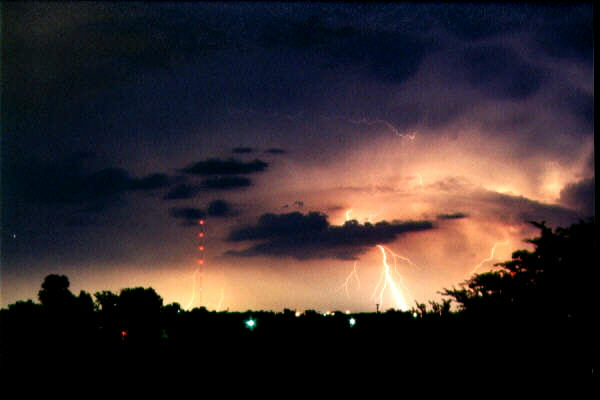 |
BASICS OF LIGHTNING PHOTOGRAPHY Something about the equipment I will assume you got the right equipment, that is, a suitable camera, a standard or wide-angle lens, a tripod, a cable-release, some 100-ASA film modules for about 80 photos total or more, and -easy does it- a chair. It's a good idea to have all this together somewhere at your place, so when at night a thunderstorm passes you don't have to search for all items. This could take some time, which you don't have, since the average thunderstorm remains active with lightning for less than an hour. I am VERY experienced in grabbing together all my stuff, trying to find some film, to locate the tripod and so, and finally rushing outwards to set it up - and then discover that the thunderstorm has ceased producing lightning. So always put all your equipment in the same place. Suitable and unsuitable locations An important thing to you is, where to setup the equipment. You can choose to photograph at your own room or whatever, you can choose to go outside on the street, or on a sidewalk - find a suitable location first, with respect to your safety. It doesn't matter much where to operate, but I recommend some place which stays dry during rain, under a roof or something. And most important, choose a place at which the view to the sky is optimal. Some situations you shouldn't be in during thunder are: being on a dike or hill, or on top of another tall object; being in the open field; being at or in the water (a lake, sea etc.); being near to trees (especially IN trees!); being indoors and very close to a window; Taking a bath, or washing your hands (indirect hit). Talking on the telephone. These are situations in which you risk being hit by lightning either directly or indirectly, and you should avoid them. The only save place to be is in a metal cage, like being in an aircraft or a car. Keep in mind that photographing lightning at a thunderstorm just overhead is DANGEROUS while being outdoors. It's best to get indoors after pressing and locking the cable release, and look through a window in the same direction as the camera outside does, and after a succesful bolt go outside to operate the camera. Your sixth sense The lightning you will be photographing will appear during night, and this brings me to another thing: believe in your sixth sense. The sense of getting awake in the middle of the night when a thunderstorm approaches, that is. Another way is not to get to sleep at all, but to stay up until three in the morning or so and wait for a storm to appear. This is only useful if you know a lot about meteorology and can reasonably predict thunderstorms. Suitable and unsuitable thunderstorms What I'm used to do if a thunderstorm is active and I spot it, is to observe it and wait for the first next lightning bolt I see, rather than immediately getting my camera, because not all thunderstorms are suitable for lightning photography. The following conditions are of little or no use at all to photograph lightning: thunderstorms producing just sheet-lightning (sheet lightning photos can be beautiful, though); embedded thunderstorms far away (about 25 miles); very weakly electrified thunderstorms, discharging every 15 minutes or so. Whereas the next ARE suitable: isolated active thunderstorms; a very active cold-front (produces a line of cumululonimbus clouds at the front line, and these are very active thunderstorms producing lightning every second or more - man can read by that); embedded thunderstorms passing over. Preparing the equipment When you decide the storm is worth to be photographed, you should by setting up your things, stick to the following checklist, in this order: setup the tripod; load camera with film if necessary; mount the right camera lens; mount the camera landscape-style on the tripod; mount the cable release on the camera; load the next photo; remove lens cap; set focus to infinity; set shutter speed to 'B' (bulb setting - manual mode); set aperture according to the lens and the film. For a 100-ASA film and a wide-angle lens use f-stop 4.0, or by distant lightning set it fully open; point the camera in the direction where most lightning bolts occur; now press the cable release and keep it pressed. If it's lockable, lock it while it's pressed, otherwise hold it in by hand; stand or sit behind the tripod, so your view and the camera's view are identical; if a bolt occurs within the view of the camera, release the shutter, load the next photo, press the cable release again, etc. As you see, there are no difficulties involved at all in lightning photography. It's mostly luck and routine that does the job. Some notes Check from time to time whether the camera lens is dry and clean, and if necessary, clean it with a new tissue VERY GENTLY. Of course you can mount the camera any way you want, but use landscape style to start with. It's a must to have a torch or something with you so you can verify the aperture setting and the focus. Furthermore it can be of great help if there is trouble changing film modules, for example. Don't turn on the light while the shutter is open, else the photo is wasted! If lightning passes outside the view of the camera, you can choose to keep the shutter open for a possible next lightning bolt, or choose to go to the next frame. When using a wide-angle lens and a 100-ASA film with f-stop 8.0 you can affort about five 'misses' before the photo has been exposed. With f-stop 4.0 or 2.8 that will be about two misses. It depends on the light emitted by the missed lightning strokes. The trouble is, if the f-stop is too low, you must load the next photo even if the lightning passed outside the camera's view, whereas too high an f-stop will cause a photographed discharge to have no visible surroundings on the print: the only thing on film is the discharge channel itself. Some more words about the lens: there is no need to use a wide-angle lens - a normal lens will work fine too, but using a wide-angle lens yields more successful photos because a larger part of the sky can be photographed. Any 50-millimeter lens or one with wider view will work just fine. |
| PHOTOGRAPHY TIPS Avoid dangerous situations! First of all, don't get struck by lightning. A good advice is to photograph lightning outside rain, while the storm is somewhat distant. If you get wet ... you get indoors. In my opinion it's a stupid thing to go in the open field to photograph close lightning - you can easily get surprised by a sneaky thunderstorm appearing out of nowhere, and this could get you into a lot of trouble. Unless you are experienced in thunderstorms and meteorology in general, you shouldn't take any risks. Anyway, photographing lightning bolts just in front of you won't get as beautiful on a photo as somewhat distant lightning illuminating the anvil and roll-clouds at the storm, etc. Best results are obtained 2 to 10 miles away from a storm, the storm being an isolated one. Check the lens cap... sit on it! Preferably, don't photograph through a window since it might show on the photo, especially when the window is wet by rain. If you DO photograph behind a window make sure the window is very clean and dry, and there is not any light coming from the back, which will show on the photo as a reflection (the light of even the faintest reflection will accumulate enough during the time the shutter is open, and will show clearly on the photo!). Don't use cardboard as an extra shutter. Forget that use of some black sheet of paper or something to put in front of the camera lens and taking away when lightning is expected. It's no use. I tried it on one of my first sessions and I put away that board maybe a milion times because I expected lightning, and when a bolt DID strike the cardboard was ... in front of the lens. [sigh] You can use this black sheet of paper to hold in front of the lens while setting the shutter open, so the possible tremor of the camera due to shutter opening won't show on the photo. But I think this is a little overkill... well you can make it a habbit, to hold your hand in front of the lens on the moment you press the shutter release. Take care not to whack the camera, when taking away the cardboard or your hand. Exposure time. In fair darkness at night, the shutter can be open as long as six minutes until the photo is 'wasted' (i.e. exposed without capturing a discharge). In the vicinity of cities or other locations having much nighttime-light an exposure-time of about 1-2 minutes is the limit. At exposures any longer than that the print will get hazy, and lightning will not have that much contrast with the background. It's best to have only the light generated by lightning on the photo, and not also some city light reflected by clouds. This time counts for a 200-ASA film. Films with lower ASA (50 - 150) can be exposed to as much as 10 to 15 minutes. It's best to experiment with this if you haven't much experience in this, for these timings seem to vary for each photographer. This is just a guideline. Stay dry. If possible, operate from under a roof or something with the camera at the edge, not letting your camera get wet by rain. Check from time to time whether the lens is clean and dry: do this with your head outside the camera's view if the shutter is open! If lightning were to occur just then while you put your smiling face in front of the lens, the effect will be very weird indeed! Coffee! Use lots to keep awake, and have something to eat with you. Pay attention to composition. You might want to mount the camera on the tripod in such a way that just a bit of horizon, a tree or something is visible. The camera of course pointed towards the direction where most discharges occur. This way the size of the photographed discharge can easily be estimated by observing the print, and it's more natural. If all this sounds odd to you, adapt your own method of positioning the camera. This is just my experience... I always have some horizon or something else as a background on my photos. It's a shame to photograph a CG (cloud to ground) discharge, without any 'ground' on the photo! Save film. Each time a discharge has occured or your photo is wasted, estimate the activity of the storm before opening the shutter for the next photo. If the storm is a weak one, you might want to wait some time before opening the shutter. It'll cost you less film. Don't wait too long! Spare camera for quick film change. If possible, get two tripods, two cameras, two cable releases and a lot of film material. Load both cameras with film, study weather forecasts, satellite images, and the sky for thunderstorm prediction. Now when photographing lightning use one camera to take the photos, and when the end of the film is reached (can be quick!) continue photographing with the other camera. In this way you won't lose time and nerves by frantically changing film (most beautiful discharges occur when changing films, odd isn't it?). By frantically changing film I think of such errors as wiping the film module out, taking a new one, accidentally putting the film just exposed in the camera again, and developing the unexposed one. Take care!. Aim at potential lightning targets. With respect to the tip concerning the two cameras, you might want to mount a telelens on the second camera and point this one portrait-style to a 'target', that is, a large tree, a chimney or a radio transmitting tower - anything which has a fair 'hit-by-lightning' ratio. I have never tried this because the one and only high object in my vicinity (a radio transmitter) has been hit only once, and lightning at my place doesn't seem to hit one object any more than another. Don't take too much time readjusting the camera. When readjusting the view of the camera (necessary to track a storm) don't keep tweaking and calibrating the camera if it's not perfectly pointing the way you want it. Just open the shutter and catch that bolt you'd otherwise have missed! I prefer a somewhat banked photo, to no photo at all because of calibrating the camera. Listen to the sferics. Use a SW/MW radio to listen real time to lightning discharges, this is very informative! Adjust the band (short wave (SW) or mid wave (MW), it doesn't matter much which band to use) so that the radio is not receiving any signal, just silent noise. When lightning strikes somewhere within, say, a 100 mile radius (that depends on conditions), you will hear a characteristic crackle (this sample sound is a singlestroke CG discharge about 7 miles distant). The crackle itself will tell you a lot more about the lightning activity, for example: Relatively long lasting crackle, with several 'pops' in it: you'll know the lightning is multistroked, thus the thunderstorms active at that time are well electrified, building enough charge separation for multistroked lightning. A long lasting crackle without that much pops in it usually indicates a long CC discharge (cloud to cloud) or an IC (intracloud) discharge; Just one pop: lightning is not that much of a discharge, thus thunderstorms are usually not active, either; Frequency of subsequent crackles: Naturally this is a direct measure for the intensity of thunderstorms; Loudness of crackles: Tells you something about the distance of the lightning discharge, to your location. Loud crackle on the radio will usually be accompanied by visible lightning, whether it be visible as heat lightning (sky lighting up), sheet lightning (cloud lighting up) or lightning channel itself. With close lightning (less than, say, a mile distant), the radio receiver will sound beserk! All this tells you a lot about the lightning activity, and thus if you're photographing and suddenly there is no more lightning activity, you may hear lightning strikes in the vicinity on the radio, which you cannot see (not even the flashes). So you might want to remain at your photography location because you're hearing crackle on the radio with increasing loudness, for example. (Read the equipment specs for more info on lightning detectors). Take care you do not re-use exposed film! When changing film modules, adapt the habbit to put exposed-film modules upside down in the module box. When doing that, you'll never be uncertain whether a film has been exposed or not. Film manufacturers always put the film modules in the boxes the same way, with the rewind knob upside-up. If you always put exposed films in the box upside down, you can immediately check (even in the dark) if a film has been exposed or not. Some cameras mangle the film end in such a way that it is obvious the film module has been exposed; for such cameras, this tip doesn't go. But it's a good habbit anyway! Always have a film loaded in the camera. Make sure that there is always a film loaded in the camera, if the camera door is closed and the camera is lying about. This eliminates the risk of an excellent lightning photography session being wasted, because at a later stage you discover there wasn't actually a film loaded in the camera. This has happened to more than one photographer, and let me tell you, it is a painful experience! Load film well in the camera. When loading a new film in your camera, stick the film through the stack cylinder as far as reasonably possible, to eliminate the risk of the film transport mechanism not having grip on the film, or the film flipping out the stack cylinder (the film won't advance, then, when taking pictures). The stack cylinder I call the tube in the camera were the film will be loaded onto. It has happened to me at a photography session on october 26th, 1998, that due to the film flipping out of the stack cylinder the film wasn't advancing: I took about 30 photos of the most beautiful lightning, not knowing by then that all photos were being exposed over eachother, on a single photo. When I found out the lightning was over. This, too, is a very painful experience! Let this not happen to you. Check and double-check your settings frequently. With each photo you make, check the following items: film rewinding capstan turning around when you load next photo; focus still set infinity. Sometimes you accidentally alter this without knowing! aperture still set correctly; camera lens still clean and dry. horizon still horizontal. (The first check is to make sure that the film is advancing in the camera when taking pictures, see also the tip about film change). |
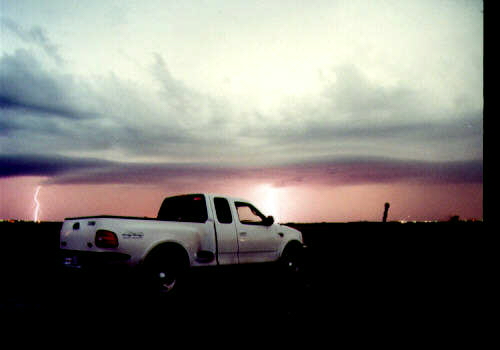 |
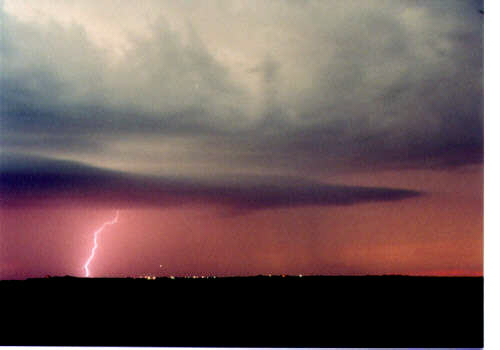
|
FREQUENTLY ASKED QUESTIONS What film should I use for photographing lightning? Use a 100 ASA film to start with. Higher ASAs mean a shorter exposure time, and lower resolution, while lower ASAs need longer exposure time, and lower f-stop for the aperture, and this makes the photos somewhat unsharp at the edges, especially when using a wide-angle lens. Which f-stop for the aperture yields best results? For 50 ASA film, set aperture fully open; for a 100 ASA film, set it to 4; for a 200 ASA film it's best to set it to 5.6. Note: the scale is somewhat logarithmic. When multiplying the ASAs by two, the f-stops should be multiplied by the square root of two. Other note: when photographing discharge channels of lightning very close to you, the aperture should be closed somewhat (means HIGHER f-stop), due to the amount of light emitted by the discharge. Important note: All these settings count for a wide-angle lens (1:2,8/28 millimeter). When using wider angle lenses close the aperture a little, and when using standard lenses such as a 50 millimeter one open it a bit. Most important note: experiment with the best f-stop setting in combination with the equipment you use. Will the photo be over-exposed when capturing two or more lightning bolts on the same photo? by having two or three bolts on the same photo, the photo won't get over-exposed, but it's a good idea to decide beforehand whether you want to do this. If you want to, you should use a higher f-stop. Keep in mind that multiple discharges on a single photo can make the illuminated clouds look ugly, due to the time interval between the discharges. Can I film lightning at night? Yes you can. You'll need a camcorder, together with a tripod to mount it on. The aperture of the camcorder should be set fully closed, the camcorder has to be set to manual mode. Don't forget to zoom the view as far out as possible (not the macroview mode), and don't forget to remove the lens cap and set the view to infinity, too. Use the camcorder only by remote lightning ( >5 miles away), else the camcorder's CCD could be damaged due to the electromagnetic field generated by the lightning. If appearing lightning bolts are too intense for your eyes, they're too intense for the camcorder too. Then stop recording, else the camcorder could also be damaged. * Warning: I declare myself irresponsible for any damage to your camcorder. I film lightning with a camcorder and so far my camcorder doesn't seem to be damaged in any way by this. But if you're unsure and/or your camcorder is an expensive one, don't take any risks by filming lightning day or night. Moreover, the manual of your camcorder should warn you of using the equipment during lightning, if it may not. To see what excellent lightning pics can be obtained with a camcorder visit Terry Pallister's site. Can I use a 400 ASA film for photographing lightning? Yes, but lower ASA films are preferred in every way. But by accidentally running out of better film, or some other reason, use it. You should set the aperture of your camera to 8 or 11. Is a photo exposed when lightning passes outside the camera's view? No it isn't, but it's best to transport anyway, because a most beautiful succeeding discharge could be ruined by a possible over- exposure. When saving film or catching multiple discharges on a single photo it doesn't need to be transported; if neccessary, close the aperture a little for the next lightning bolt. I own an automatic camera. Can I photograph lightning with this? An automatic camera can be used only: - if the exposure-time can be set to 'B' (manual mode), and - if the aperture can be set to a fixed f-stop manually; - OR if it is equipped with an automatic lightning-activated trigger (see my links page for links to schematics or commercial devices). It's best to obtain an old manual camera, which is just perfect for the job. If you decide to invest big money in your equipment, primairily invest in a professional wide-angle camera lens rather than in a professional camera. How do I photograph daytime lightning? Setup your camera on a tripod, mount a cable release and set exposure time (not B!) and aperture according to the light sensor of the camera. Now wait until a lightning bolt appears, in this case immediately press the release. You should be able to catch a post- discharge this way. If the lightning bolts don't flicker but only flash once at a strike, don't waste any film by trying to. Your reaction time will lag the flash at least 100 milliseconds. Another way to photograph lightning at broad daylight is to use an automatic lightning-activated camera trigger device. You can build one yourself if you're at home in electronics, else you can buy triggers on the internet. Check my links page for links to schematics and commercial triggers. |
| thunderstorms and lightning...THE UNDERATED KILLERS thunderstorms...and their offspring Thunderstorms affect relatively small areas when compared with hurricanes and winter storms. The typical thunderstorm is 15 miles in diameter and lasts an average of 30 minutes. Nearly 1,800 thunderstorms are occurring at any moment around the world. That's 16 million a year! Despite their small size, all thunderstorms are dangerous. Every thunderstorm produces lightning, which kills more people each year than tornadoes. Heavy rain from thunderstorms can lead to flash flooding. Strong winds, hail, and tornadoes are also dangers associated with some thunderstorms. Of the estimated 100,000 thunderstorms that occur each year in the United States, only about 10 percent are classified as severe. Your National Weather Service considers a thunderstorm severe if it produces hail at least 3/4-inch in diameter, wind 58 mph or higher, or tornadoes. Take the time NOW to understand these dangers and learn basic safety rules.
|
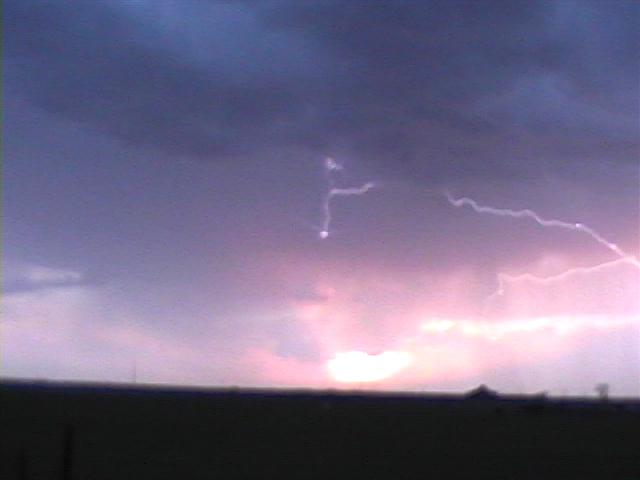 |
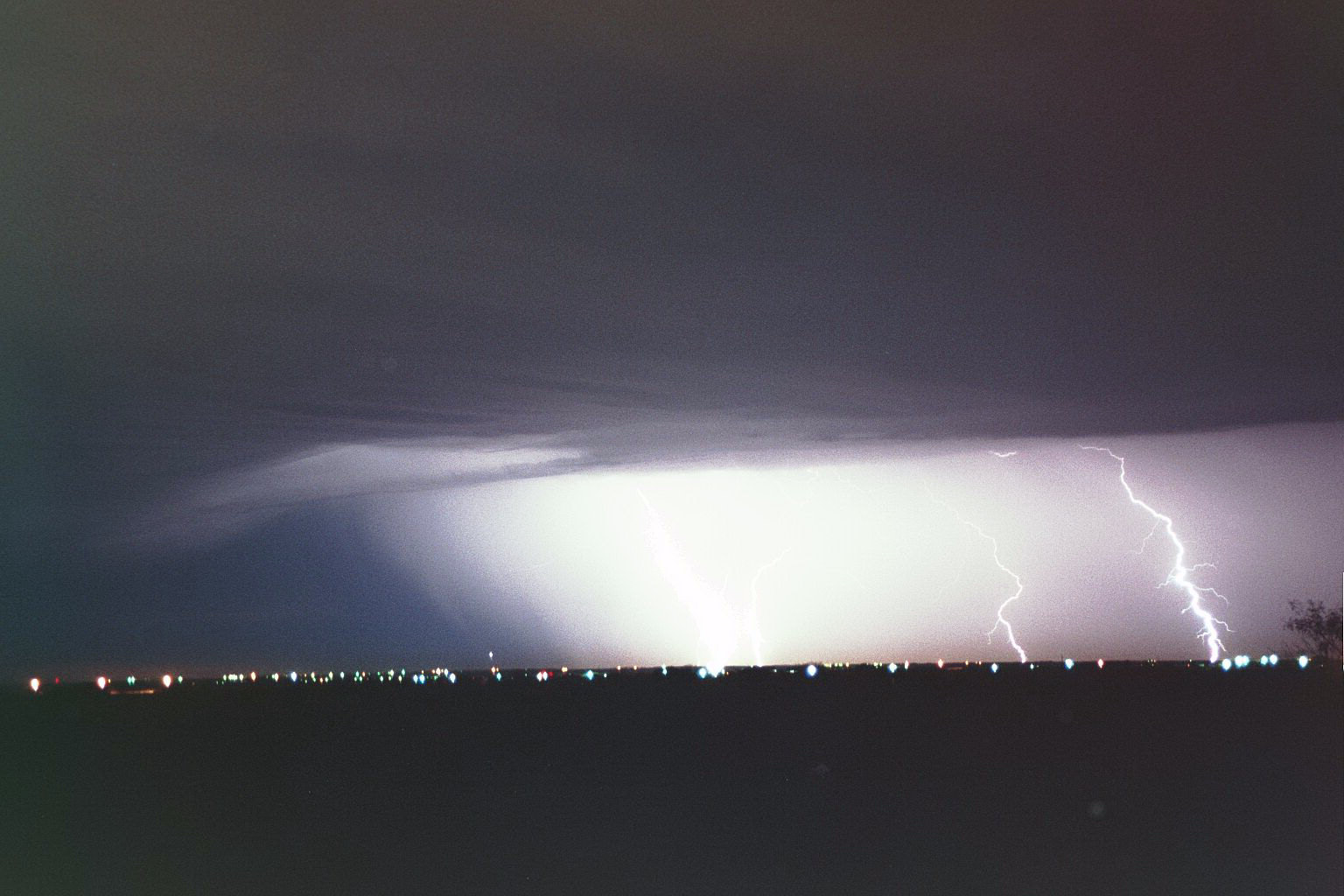 |
lightning... nature's fireworks What is Lightning? The action of rising and descending air within a thunderstorm separates positive and negative charges. Water and ice particles also affect the distribution of electrical charge. Lightning results from the buildup and discharge of electrical energy between positively and negatively charged areas. The average flash could light a 100-watt light bulb for more than 3 months. Most lightning occurs within the cloud or between the cloud and ground. Your chances of being struck by lightning are estimated to be 1 in 600,000 but could be reduced by following safety rules. Most lightning deaths and injuries occur when people are caught outdoors. Most lightning casualties occur in the summer months and during the afternoon and early evening. The air near a lightning strike is heated to 50,000øF hotter than the surface of the sun! The rapid heating and cooling of air near the lightning channel causes a shock wave that results in thunder. Many fires in the western United States and Alaska are started by lightning. In the past decade, over 15,000 lightning-induced fires nationwide have resulted in several hundred million dollars a year in damage and the loss of 2 million acres of forest. In recent years, people have been killed by lightning while: boating standing under a tree playing soccer swimming riding on a lawnmower fishing in a boat golfing talking on the telephone mountain climbing bike riding loading a truck lightning can strike anywhere! In recent years, sophisticated lightning detection equipment has monitored cloud-to-ground lightning strikes. The map at right shows which areas were MOST prone to lightning during one year. Which way does lightning travel? A cloud-to-ground lightning strike begins as an invisible channel of electrically charged air moving from the cloud toward the ground. When one channel nears an object on the ground, a powerful surge of electricity from the ground moves upward to the cloud and produces the visible lightning strike! |
| Lightning Myths and Facts MYTH: If it is not raining, then there is no danger from lightning. FACT: Lightning often strikes outside of heavy rain and may occur as far as 10 miles away from any rainfall. MYTH: The rubber soles of shoes or rubber tires on a car will protect you from being struck by lightning. FACT: Rubber-soled shoes and rubber tires provide NO protection from lightning. However, the steel frame of a hard-topped vehicle provides increased protection if you are not touching metal. Although you may be injured if lightning strikes your car, you are much safer inside a vehicle than outside. MYTH: People struck by lightning carry an electrical charge and should not be touched. FACT: Lightning-strike victims carry no electrical charge and should be attended to immediately. Contact your local American Red Cross chapter for information on CPR and first aid classes. MYTH: "Heat lightning" occurs after very hot summer days and poses no threat. FACT: What is referred to as "heat lightning" is actually lightning from a thunderstorm too far away for thunder to be heard. However, the storm may be moving in your direction! |
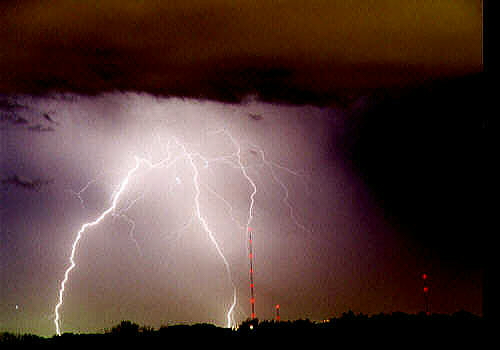 |
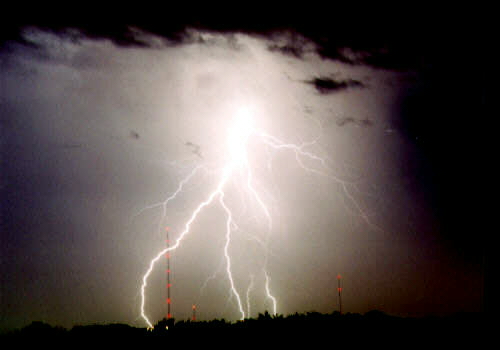 |
environmental clues When skies darken or thunderstorms are forecast, look AND listen for Increasing wind. Flashes of lightning. Sound of thunder. Static on your AM radio. To estimate the distance in miles between you and the lightning flash, count the seconds between the lightning and the thunder and divide by five. Advanced Weather Radar Sees "Inside" the Storm Doppler Radars, which are being strategically deployed around the country, are capable of seeing "inside" a thunderstorm to detect hazardous weather conditions. New storms often form along leading edge of the storm's cool-air outflow; this feature is able to be detected on Doppler Radar. |
| WHATS YOUR PLAN STAY INFORMED ABOUT THE STORM by listening to NOAA Weather Radio, commercial radio, and television for the latest severe thunderstorm WATCHES and WARNINGS. When conditions are favorable for severe weather to develop, a severe thunderstorm WATCH is issued. Weather Service personnel use information from weather radar, satellite, lightning detection, spotters, and other sources to issue severe thunderstorm WARNINGS for areas where severe weather is imminent. Severe thunderstorm warnings are passed to local radio and television stations and are broadcast over local NOAA Weather Radio stations serving the warned areas. These warnings are also relayed to local emergency management and public safety officials who can activate local warning systems to alert communities. NOAA WEATHER RADIO IS THE BEST MEANS TO RECEIVE WARNINGS FROM THE NATIONAL WEATHER SERVICE The National Weather Service continuously broadcasts updated weather warnings and forecasts that can be received by NOAA Weather Radios, which are sold in many stores. The average range is 40 miles, depending on topography. Your National Weather Service recommends purchasing a radio that has both a battery backup and a tone-alert feature that automatically alerts you when a watch or warning is issued. What to Listen For... SEVERE THUNDERSTORM WATCH: tells you when and where severe thunderstorms are more likely to occur. Watch the sky and stay tuned to know when warnings are issued. Watches are intended to heighten public awareness and should not be confused with warnings. SEVERE THUNDERSTORM WARNING: issued when severe weather has been reported by spotters or indicated by radar. Warnings indicate imminent danger to life and property to those in the path of the storm. Also listen for Tornado Watch or Warning and Flash Flood Watch or Warning. Also...listen for Tornado Watch or Warning and Flash Flood Watch or Warning. |
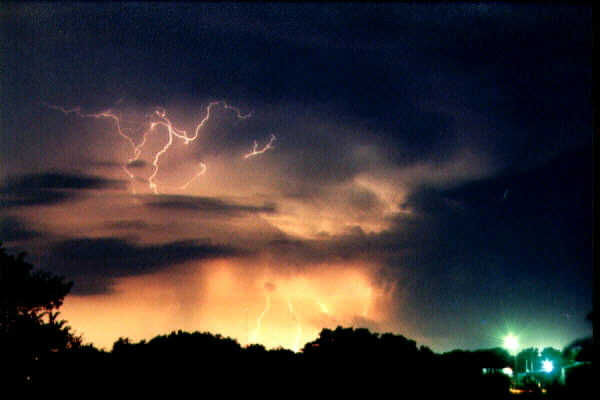 |
|
|
FAMILY DISASTER PLAN Families should be prepared for all hazards that could affect their area. NOAA's National Weather Service, the Federal Emergency Management Agency, and the American Red Cross urge every family to develop a family disaster plan. Where will your family be when disaster strikes? They could be anywhere_at work, at school, or in the car. How will you find each other? Will you know if your children are safe? Disaster may force you to evacuate your neighborhood or confine you to your home. What would you do if basic services_water, gas, electricity or telephones_were cut off? Follow these basic steps to develop a family disaster plan... I. Gather information about hazards. Contact your local National Weather Service office, emergency management office, and American Red Cross chapter. Find out what type of disasters could occur and how you should respond. Learn your community's warning signals and evacuation plans. II. Meet with your family to create a plan. Discuss the information you have gathered. Pick two places to meet: a spot outside your home for an emergency, such as fire, and a place away from your neighborhood in case you can't return home. Choose an out-of-state friend as your "family check-in contact" for everyone to call if the family gets separated. Discuss what you would do if advised to evacuate. III. Implement your plan. (1) Post emergency telephone numbers by phones; (2) Install safety features in your house, such as smoke detectors and fire extinguishers; (3) Inspect your home for potential hazards (such as items that can move, fall, break, or catch fire) and correct them; (4) Have your family learn basic safety measures, such as CPR and first aid; how to use a fire extinguisher; and how and when to turn off water, gas, and electricity in your home; (5) Teach children how and when to call 911 or your local Emergency Medical Services number; (6) Keep enough supplies in your home to meet your needs for at least three days. Assemble a disaster supplies kit with items you may need in case of an evacuation. Store these supplies in sturdy, easy-to-carry containers, such as backpacks or duffle bags. Keep important family documents in a waterproof container. Keep a smaller disaster supplies kit in the trunk of your car. A DISASTER SUPPLIES KIT SHOULD INCLUDE: A 3-day supply of water (one gallon per person per day) and food that won't spoil one change of clothing and footwear per person one blanket or sleeping bag per person a first aid kit, including prescription medicines emergency tools, including a battery-powered NOAA Weather Radio and a portable radio, flashlight, and plenty of extra batteries an extra set of car keys and a credit card or cash special items for infant, elderly, or disabled family members. IV. Practice and maintain your plan. Ask questions to make sure your family remembers meeting places, phone numbers, and safety rules. Conduct drills. Test your smoke detectors monthly and change the batteries two times each year. Test and recharge your fire extinguisher(s) according to manufacturer's instructions. Replace stored water and food every 6 months. Contact your local National Weather Service office, American Red Cross chapter, or local office of emergency management for a copy of "Your Family Disaster Plan" |
|
A FINAL NOTE |
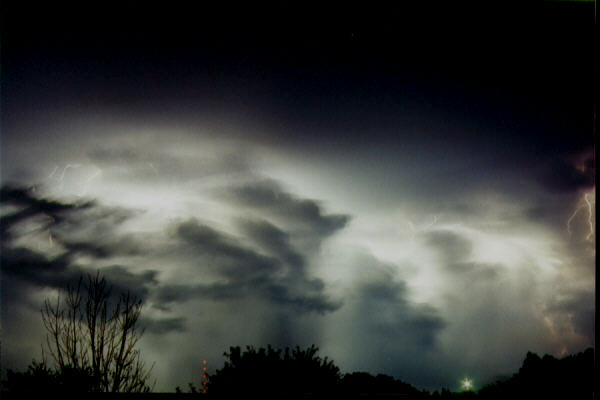 |